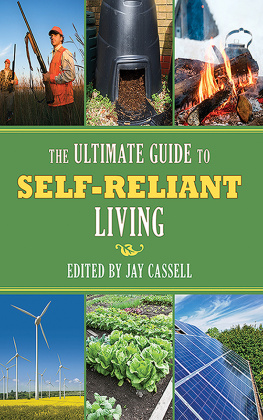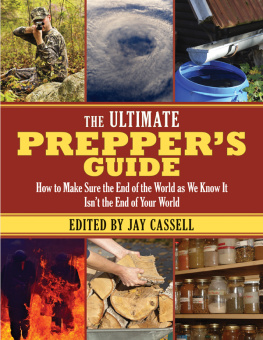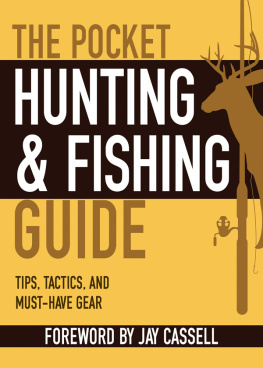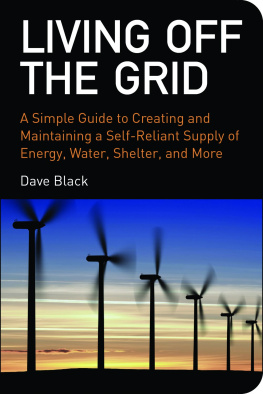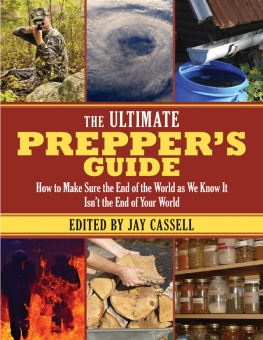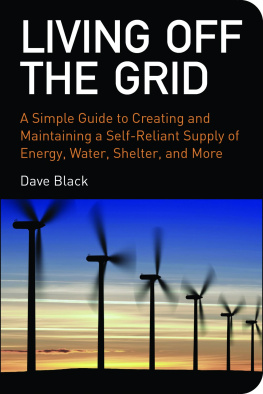Jay Cassell - Ultimate Guide to Self-Reliant Living, The
Here you can read online Jay Cassell - Ultimate Guide to Self-Reliant Living, The full text of the book (entire story) in english for free. Download pdf and epub, get meaning, cover and reviews about this ebook. year: 2012, publisher: Skyhorse Publishing (Perseus), genre: Children. Description of the work, (preface) as well as reviews are available. Best literature library LitArk.com created for fans of good reading and offers a wide selection of genres:
Romance novel
Science fiction
Adventure
Detective
Science
History
Home and family
Prose
Art
Politics
Computer
Non-fiction
Religion
Business
Children
Humor
Choose a favorite category and find really read worthwhile books. Enjoy immersion in the world of imagination, feel the emotions of the characters or learn something new for yourself, make an fascinating discovery.
- Book:Ultimate Guide to Self-Reliant Living, The
- Author:
- Publisher:Skyhorse Publishing (Perseus)
- Genre:
- Year:2012
- Rating:5 / 5
- Favourites:Add to favourites
- Your mark:
- 100
- 1
- 2
- 3
- 4
- 5
Ultimate Guide to Self-Reliant Living, The: summary, description and annotation
We offer to read an annotation, description, summary or preface (depends on what the author of the book "Ultimate Guide to Self-Reliant Living, The" wrote himself). If you haven't found the necessary information about the book — write in the comments, we will try to find it.
Ultimate Guide to Self-Reliant Living, The — read online for free the complete book (whole text) full work
Below is the text of the book, divided by pages. System saving the place of the last page read, allows you to conveniently read the book "Ultimate Guide to Self-Reliant Living, The" online for free, without having to search again every time where you left off. Put a bookmark, and you can go to the page where you finished reading at any time.
Font size:
Interval:
Bookmark:
to Self-Reliant Living
to Self-Reliant Livin
Edited byJay Cassell

Skyhorse Publishing
Copyright 2013 by Jay Cassell
All Rights Reserved. No part of this book may be reproduced in any manner without the express written consent of the publisher, except in the case of brief excerpts in critical reviews or articles. All inquiries should be addressed to Skyhorse Publishing, 307 West 36th Street, 11th Floor, New York, NY 10018.
Skyhorse Publishing books may be purchased in bulk at special discounts for sales promotion, corporate gifts, fund-raising, or educational purposes. Special editions can also be created to specifications. For details, contact the Special Sales Department, Skyhorse Publishing, 307 West 36th Street, 11th Floor, New York, NY 10018 or info@skyhorsepublishing.com.
Skyhorse and Skyhorse Publishing are registered trademarks of Skyhorse Publishing, Inc., a Delaware corporation.
Visit our website at www.skyhorsepublishing.com.
10 9 8 7 6 5 4 3 2 1
eISBN: 978-1-62873-558-1
Library of Congress Cataloging-in-Publication Data is available on file. ISBN: 978-1-62636-093-8
Printed in Canada
JAY CASSELL
H undreds of years ago, the majority of the worlds population was self-sufficient. People made their own clothing, tools, weapons, boats, and shelters; they hunted, fished, trapped, and grew and harvested their own food. Energy was supplied by animal power, then by wind and water. But as the human population of the world grew, the wild food supply dwindled and people began to rely more on herding and farming than on hunting and gathering. Today, most people in the world depend on a relatively small number of farmers to grow food for them. Many people in developed nations work in jobs that have little to do with the essentials of living, instead trading the money they make to buy food, clothes, and shelter.
Food, clothes, shelter, warmth, energyif you were tossed into the middle of the woods and told to survive on your own, Im guessing you probably could not. Could you find your own food? Build a shelter that would keep you warm and dry? Start a fire without a butane lighter? Harness energy to provide power?
Despite this, there is a growing movement across this country, led by people who want to get off the grid, go back to basics, and live a simple life free from the constraints of modern civilization. Some people are doing it for peace of mind; others object to living in a fast-paced world where no one is independent, where everyone depends on others; a third, growing group feels that Armageddon may be upon us, and that only those who are prepared to live on their own will survive.
In this book, youll find all the information youll need to survivebe it on your own plot of land somewhere out in the wilderness, or the home youre in now, once all the power goes out and you need to fend for yourself. In these pages, youll learn about starting fires, in multiple ways with multiple sources; growing and harvesting not only fruits and vegetables, but pigs, chickens, and even fish. There are tips and tactics in here on hunting, trapping, and fishing, outdoor skills everyone should know; and there is useful, solid information on staying alive and thriving in true survival situations.
Its my hope that everyone who reads this book will come away being much smarter and able to survive anywhere, in any situation. Because you know what? You may need to.
Jay Cassell
Katonah, New York
August 2, 2013
to Self-Reliant Living
Buying Property
and Building on It
Realizing the Dream of Owning a Place in the Country
W ith careful planning and a modest investment, almost anyone can turn the dream of owning a small farm or a few acres of country land into a reality. And with some effort this land may provide a significant portion of lifes amenities: wood for the fireplace, fresh produce for the table, a pond for fishing or swimmingeven waterpower to generate electricity. But as with any other major purchase, care and caution are required.
The first step is to have, in general terms, a strong notion of what it is you want. Those desiring year-round warmth will obviously have different priorities than those who wish to see the seasons change. Prospective part-time farmers will look for one kind of land, whereas weekend sojourners will look for another. Whether you enjoy isolation or prefer neighbors near is another consideration to ponder. And, of course, there is the matter of money: how much you can afford to put down, how much you can pay each month for a mortgage and taxes. Once you have made these decisions, pick an area or two to investigate. Get the catalogs of the Strout and United Farm real estate agencies, and look for ads in the Sunday paper real estate section. Also subscribe to local papers from the regions of your interest; these may provide lower-priced listings plus information on land auctions.
When a property appeals to you, investigate first by phone and then in person. When looking, do not neglect small matters, such as television reception, the contours of the land, and the style of the farmhouse; but never lose sight of your ultimate goals or basic priorities, and gauge the property in that light.
To buy or not to buyresist that impulse. Once you have found a piece of property that appears to meet your needs, resist the temptation to come to terms. This is the time for an in-depth investigation rather than a purchase. After leaving the parcel, think about it, talk about it, try to remember its contours, and list all the things you do not like as well as the things you do. If after a week or so the land is still appealing, arrange to spend an entire day tramping about it.
Walk slowly about the property in the company of your family. Among the subjects of discussion should be these: Is the ratio of meadow to woodlot about what you have in mind? (The former are generally more valuable as timber and fuel.) Is the meadow overlain with ground cover, indicating some fertility? Is it swampy? Is there a usable residence on the property? If not, can you afford to build? Is there a road that cuts across the property into a neighbors driveway? If so, there is likely to be an easement on the parcel, conferring on the neighbor the right to cross at will. If there is no electricity, gas, or telephone service, ask yourself honestly how well you can get along without these conveniences. And if your goal is to be a part-time farmer and full-time resident, check into employment possibilities in the area.
If the answers to most of these questions are satisfactory, then begin a more formal survey of the property For those who plan to grow vegetables, grains, or fruits, the question of soil fertility becomes a major factor in any ultimate decision. Take a spade and dig downway downin several widely scattered places. Ground that is adequate for good crops will have a layer of topsoil at least 10 inches deep; 12 or 15 inches deep is better. The topsoil should be dark, and when handled it should feel soft, loose, and crumbly to the touch. If the topsoil seems rich and deep enough, make doubly certain by taking several samples to the nearest county agent; he can analyze it for acidity (pH) and mineral content and tell you what crops are best to grow on it. Another way of discovering what crops the soil will support is to find out what the neighbors are growing. If the farm over the fence has a healthy stand of corn, and a thriving vegetable garden, the chances are good that the land you are looking at will also accommodate those crops.
Font size:
Interval:
Bookmark:
Similar books «Ultimate Guide to Self-Reliant Living, The»
Look at similar books to Ultimate Guide to Self-Reliant Living, The. We have selected literature similar in name and meaning in the hope of providing readers with more options to find new, interesting, not yet read works.
Discussion, reviews of the book Ultimate Guide to Self-Reliant Living, The and just readers' own opinions. Leave your comments, write what you think about the work, its meaning or the main characters. Specify what exactly you liked and what you didn't like, and why you think so.

